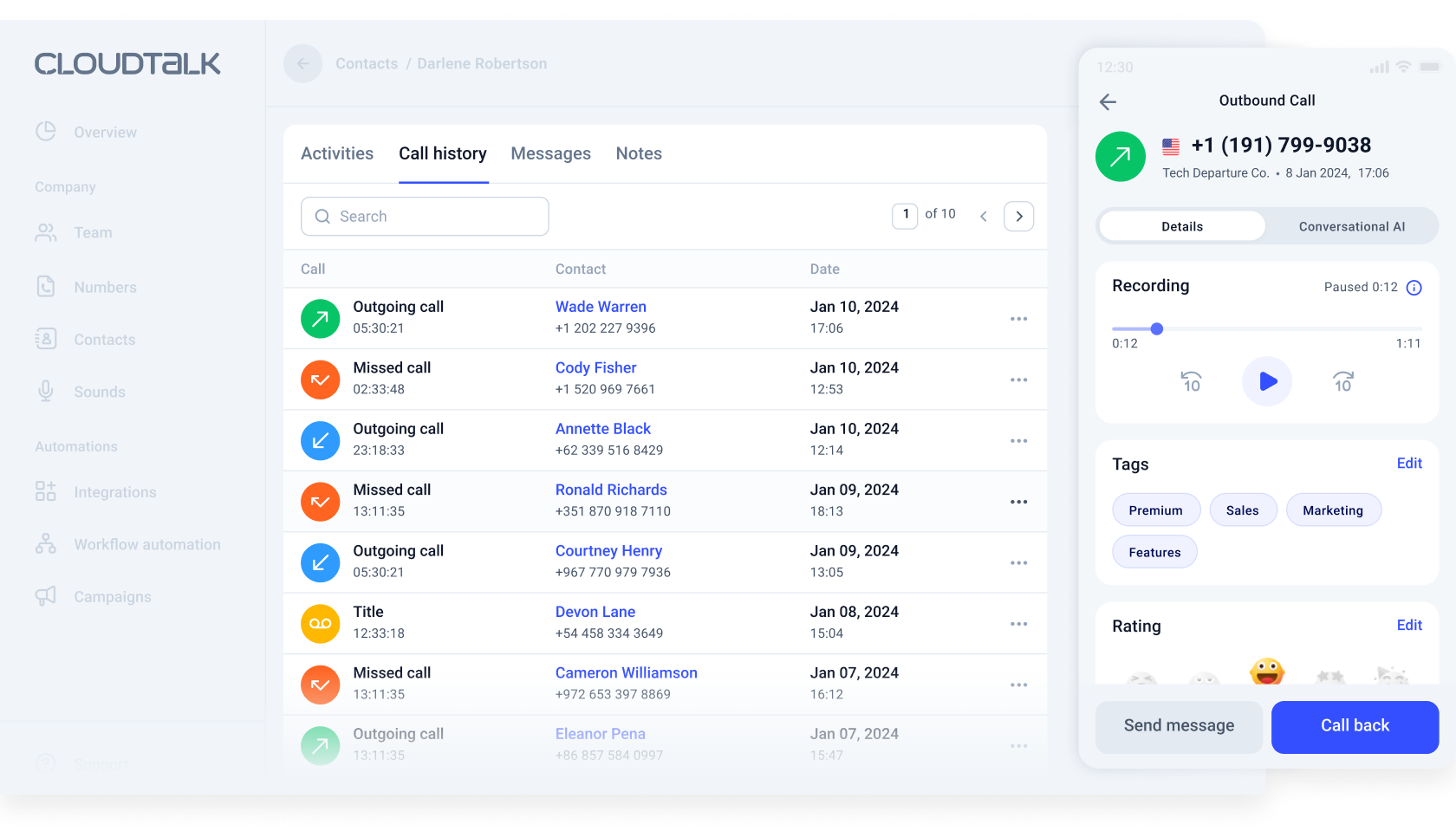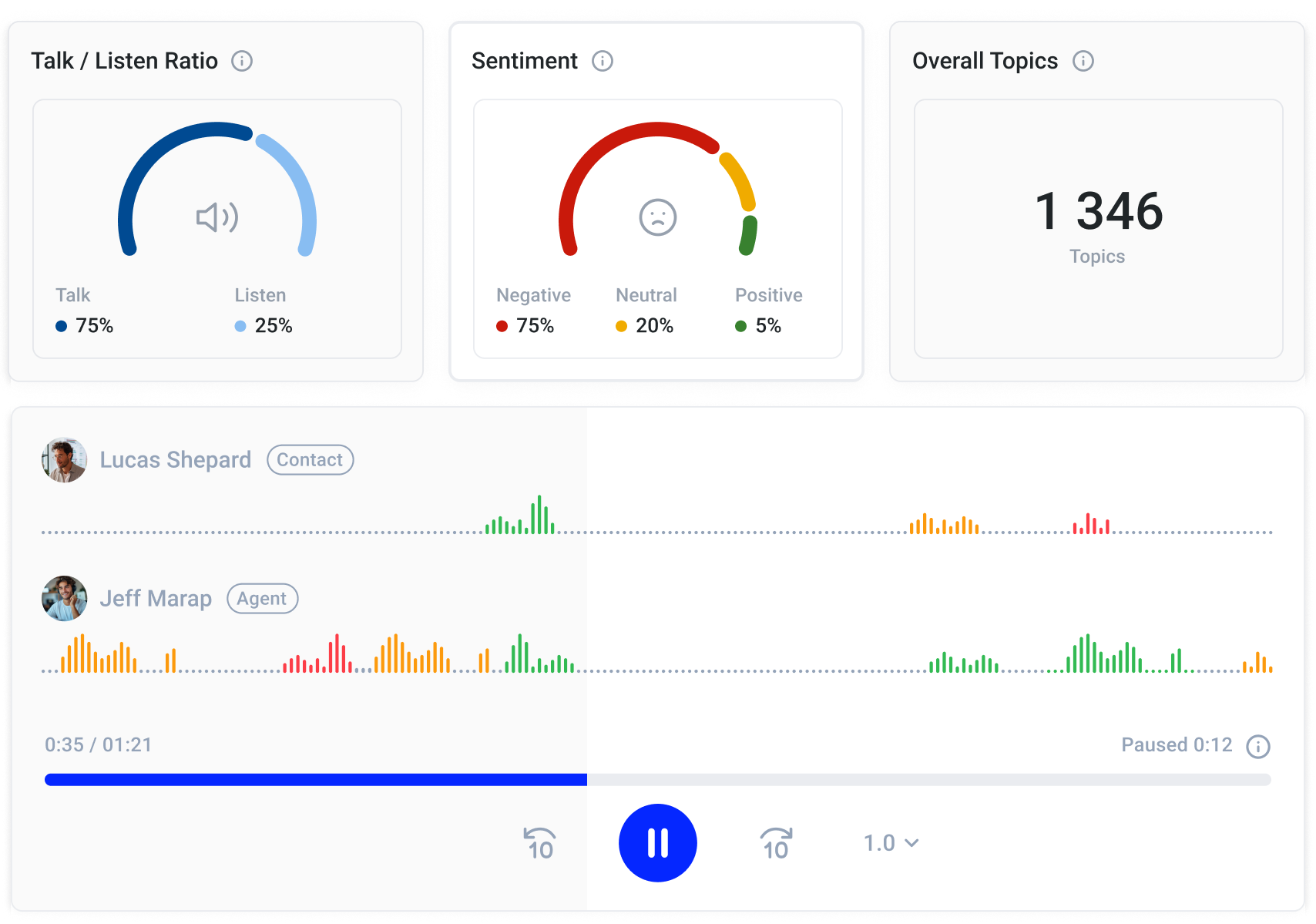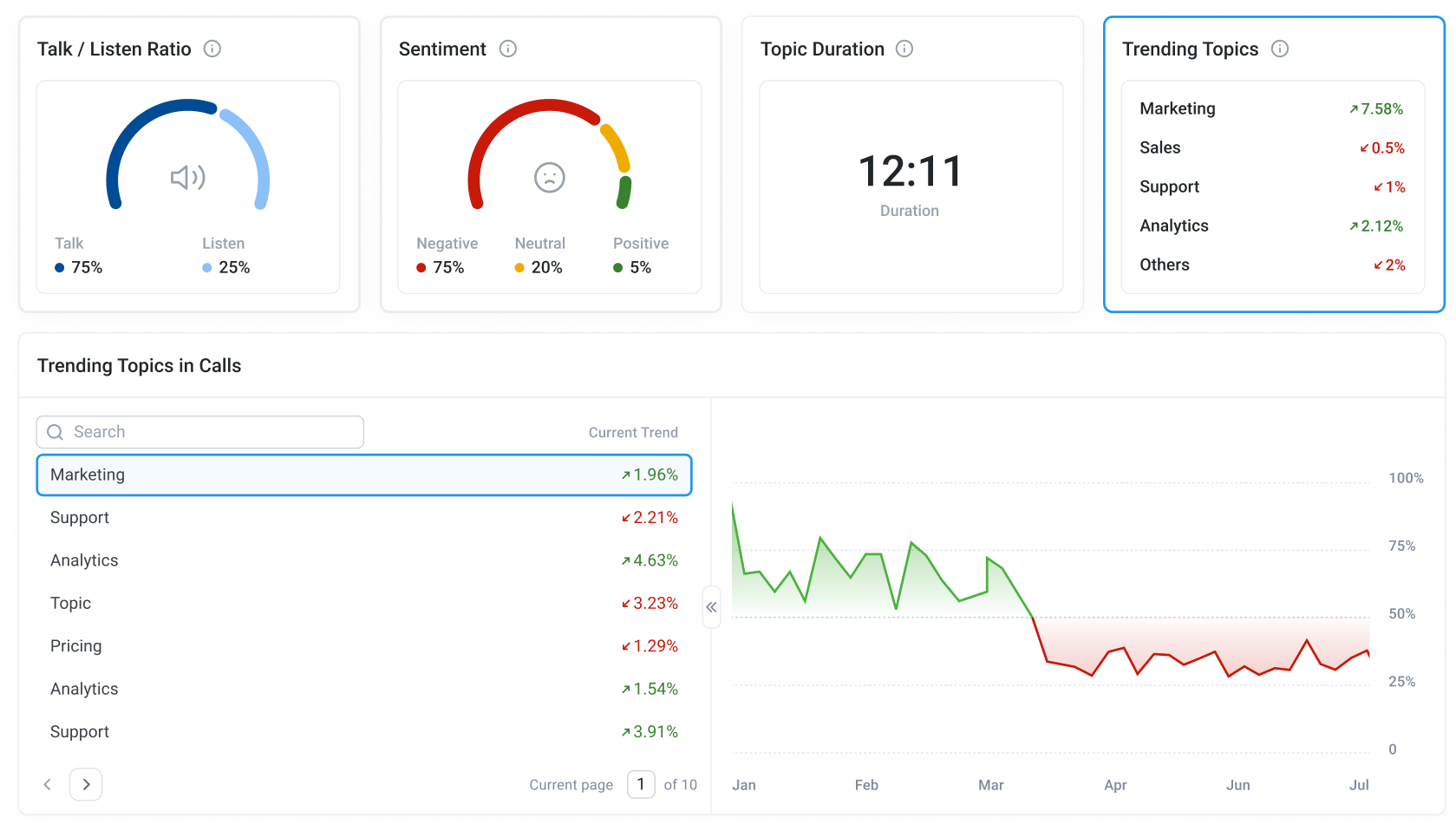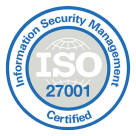What Is a Contact Center Strategy—And Why It Matters
A contact center strategy is your organization’s game plan for delivering consistent, high-quality customer interactions across communication channels. It defines how your contact center operates, evolves, and aligns with business goals.
Why does this matter? Because without a clear strategy, contact centers become reactive, fragmented, and inefficient. A strong strategy ensures:
-
Operational clarity: Everyone from agents to supervisors understands workflows, priorities, and performance targets.
-
Customer satisfaction: Experiences are streamlined, helpful, and on-brand, leading to higher retention and loyalty.
-
Scalability: As your business grows, your contact center can expand without sacrificing quality or control.
-
Data-driven decisions: With the right call center software in place, you can use insights to refine processes and make informed decisions.
In short, a contact center strategy transforms call center operations from a cost center into a growth engine, driving both customer engagement and sales outcomes.
The Four Core Elements of a Contact Center
A strong call center strategy is shaped by the everyday realities of how your team works, how customers interact with you, and how technology supports both.
To make strategy actionable—not just theoretical—you need to build it around four operational pillars: people, processes, technology, and customers. These elements define how your contact center functions day to day.
-
People: A smart strategy prioritizes recruiting, onboarding, and coaching agents to resolve issues and create customer experiences that build trust and loyalty.
-
Processes: Clear, repeatable systems are the engine behind every successful operation. They ensure every interaction is handled consistently and effectively.
-
Technology: The right tech stack is a strategy multiplier. With contact center software features like smart dialers and integrated CRMs, you make your operation more efficient and your team more productive.
-
Customers: Every strategic decision should be rooted in customer understanding. A successful strategy includes feedback loops and data analysis to continually adapt and improve how your center serves its audience.
In the next sections, we’ll break down each of these pillars to show how they impact your contact center strategy.
People: Building the Team Behind Every Interaction
A contact center’s structure shouldn’t live on paper—it should live in motion. It’s the team that brings your contact center strategy to life, putting it to work every day.
A well-structured contact center team ensures the right people are in place to support strategic goals, with clear paths for communication, accountability, and performance improvement.
Here’s a simple breakdown of how most contact centers are structured:
| Typical Level | Role | Duties |
|---|---|---|
| Managerial | Call Center Manager | Hiring, training, and motivating staff members to do their best work. Setting goals, helping staff hit targets, analyzing and tweaking targets. |
| Managerial | Team Leader | Often, the link between staff and managers. Call center monitoring, training, supporting staff, managing, and reporting performance. |
| Senior | Quality Assurance | Responsible for ensuring the product meets company quality standards. Detail-oriented from design to implementation, and problem-solving. |
| Senior | Technical Support Agent | Someone with detailed know-how on the product. Translating technical knowledge into simple and useful advice to solve customer issues quickly. |
| Starter to Senior | Customer Service Representative | Combines product and service knowledge with representing the company well. Solving customer questions and issues professionally. |
| Starter (typically) | Outbound Call Center Agent / Telemarketing | A type of sales role. Reaching out to potential customers to generate interest and/or sell to new prospects persuasively and helpfully. |
Processes: Creating Consistency in Every Workflow
Processes are the workflows that hold your contact center strategy together. They define how work gets done, how handoffs happen, and how customers move from problem to resolution.
Think of processes as the structure behind smooth execution. They turn your call center strategies from plan to practice, and make high performance something you can train, measure, and repeat.
That includes everything from how inbound calls are prioritized to how follow-ups are scheduled or even how new hires are trained. Small systems that, when optimized, make your strategy run smoother at every touchpoint.
Technology: Equipping Your Team with the Right Tools
Technology is the engine room of any efficient contact center strategy. It gives your team the tools to execute processes, make smarter decisions, and deliver better customer experiences at scale.
And that’s exactly why tech choices matter. The right virtual call center software doesn’t just manage calls. It routes them smartly, pulls in context from CRMs, tracks performance, and gives agents the tools they need to resolve issues faster and more effectively.
Solutions like CloudTalk are built with this in mind. From intelligent routing and analytics to seamless integrations with CRMs and helpdesks, CloudTalk helps teams stay sharp, informed, and aligned.
Customers: Delivering What They Expect with the Three C’s
Lastly, among the four core elements that shape your contact center strategy, customers are the one constant that defines success from the outside in. Your people, processes, and technology all exist to support them.
To bring clarity and focus to that experience, the Three C’s serve as a simple yet powerful framework. These principles help you get your contact center to deliver the kind of service today’s customers expect.
-
Consistency: Your strategy should ensure that no matter when or how a customer reaches out, they get the same high-quality service. This builds reliability and trust across every touchpoint.
-
Customization: A strategic approach uses data to personalize interactions. Whether it’s greeting a customer by name, referencing past issues, or recommending the best products for their profile.
-
Convenience: When customers call, they expect clear IVRs, minimal wait times, agents who already have their context, and resolutions without being bounced around. Your contact center strategy should make that happen.

Give your contact center space to think beyond the next call

18 Contact Center Strategies That Drive Real Business Growth
These 18 contact center strategies go beyond surface-level fixes. They’re built to improve performance, boost customer loyalty, and scale your operation with confidence.
1. Align Contact Center KPIs with Company Goals
For starters, your contact center doesn’t exist in a vacuum; it’s a direct link between your business goals and your customers. If your KPIs aren’t aligned with the company’s objectives, your team might be measuring success in a completely different language.
Aligning KPIs like average handle time, FCR, or CSAT with broader company goals—such as increasing retention or earning more clients—helps your team see how their work moves the business forward. It turns daily tasks into strategic contributions.
This alignment isn’t just about reporting—it’s about purpose. When agents understand their part in the company’s bigger picture, everyone rows in the same direction.
2. Know What Your Customers Want
What do your customers actually expect when they contact you? It’s not bells and whistles—it’s to feel heard, valued, and helped. They want solutions, yes—but also reassurance that they matter to your business.
The better you know what they need, the better your agents can meet them where they are. CloudTalk features like Sentiment Analysis and Topic Extraction give you insight into what customers feel and care about most.
When you align your service with what your customers truly want, everything else—loyalty and satisfaction—falls into place.
3. Create a Governance Model for Process & Quality
Consistency doesn’t happen by chance; it’s created. Without a clear governance model, process documentation gets outdated, quality reviews slip, and agents end up working from different playbooks.
Set up a governance model that defines who’s responsible for updating SOPs, maintaining the knowledge base, and running regular Quality Assurance reviews. Make those roles visible, documented, and ongoing—not one-time tasks.
With clear ownership in place, your contact center strategies won’t get lost in the shuffle. Everyone knows where to find answers, what “good” looks like, and how to keep improving without starting from scratch.
4. Hire Agents Who Reflect Your Values
Every contact center relies on people to carry the customer experience—and who you hire makes a lasting impact. Filling seats fast might ease short-term pressure, but it rarely builds long-term strength.
Look for qualities that outlast onboarding: empathy, adaptability, and a genuine interest in solving problems. These traits drive better conversations and help agents stay composed, even under pressure.
Hiring well isn’t just about qualifications—it’s about finding people who align with your team’s values and your customers’ expectations. The difference is felt on every call.
5. Train Regularly to Keep Quality on Point
Onboarding is just the beginning. What really sets high-performing teams apart is what happens after the first week. Ongoing training helps agents stay sharp, adapt to change, and grow with your customer expectations.
Don’t just hand out manuals. With tools like Call Monitoring, you can jump into live conversations and coach on the spot, while Agent Reporting gives you a clear view of performance trends, so you know exactly where to focus your feedback.
Using CloudTalk, coaching becomes part of the workflow—not a one-off. And when training turns into routine, quality turns into consistency. That’s how strong contact centers stay strong.
6. Keep Your Team Engaged, Not Just Active
A motivated team is more than a performance boost; it’s your best defense against burnout. When agents are engaged in their work and enjoy how they do it, they stay focused, resilient, and committed for the long haul.
Create an environment where challenge and fun can coexist. Set clear goals, build in friendly competition, and highlight wins often—individually and as a team. Even small moments of recognition can shift the tone of an entire day.
You don’t need ping-pong tables to make work enjoyable. What matters is giving people a reason to care—opportunities to grow, freedom to experiment, and the tools to succeed. Engagement is part of your strategy to build a high-performing team.
7. Build a Culture That Puts Customers First
Every call, SMS, or ticket is part of a bigger story—and customers remember how it made them feel. Creating a customer-centric culture means designing every part of the journey with that memory in mind.
Start by mapping the end-to-end experience. Where does confusion creep in? Where do handoffs break? When you spot these weak points, redesign the experience to feel seamless from start to finish.
This isn’t just about better scripts or faster replies. It’s about shifting how your team sees their role—from task-driven to relationship-focused. When everyone aligns around the customer, loyalty follows.
8. Measure What Truly Matters
Not all metrics move the needle. You can track call volume, handle time, and agent availability all day—but if those numbers aren’t tied to meaningful outcomes, they’re just noise.
With tools like CloudTalk’s Analytics, you get a clear view into what’s working and what needs attention—like calls that consistently run long, low first-call resolution rates. And with the Wallboard, you can display key metrics in real time, keeping your team aligned.
When you use data the right way, you don’t just collect insights—you use it to drive performance, optimize resources, and make confident decisions that move your contact center forward.
9. Automate the Routine to Amplify the Results
Every minute your agents spend on repetitive tasks is a minute they’re not helping customers. That’s where automation gives you an edge.
With CloudTalk’s Auto Dialers, agents can move from call to call without manual dialing, while Workflow Automation takes care of things like follow-up scheduling, reminders, and post-call surveys. Less admin, more momentum.
Layer in contact center integration with your CRM, helpdesk, or e-commerce tools, and you’ve got real-time data sync. Calls are logged automatically, customer context is always available, and agents spend less time clicking—and more time connecting.
When the routine runs in the background, your team can stay present in the conversation. That means faster resolutions, stronger connections, and more impact with less effort.
10. Use AI to Unlock Smarter Service
AI takes automation and data analysis a step further, managing routine tasks more intelligently while revealing insights behind them.
AI Voice Agents are a prime example. They can qualify leads, route calls, gather post-call feedback, or answer common questions—no hold music, no handoffs. That frees up your team while keeping service consistent and fast.
But AI doesn’t stop at execution. With Conversation Intelligence, it helps uncover patterns, flag friction points, and surface customer trends in real time. The result? A smarter, more adaptive contact center strategy—one that evolves as quickly as your customers do.
Curious how CloudTalk’s AI Voice Agent sounds? Meet CeTe in the interactive section right below.

AI Voice Agents
Sales Reminder
Agent
Client
Sales / Marketing
Course Inquiry
Agent
Client
Education / EdTech
Payment Reminder
Agent
Client
Financial Services
Healthcare Intake
Agent
Client
Healthcare
Insurance Intake
Agent
Client
Insurance
T&C Acceptance
Agent
Client
Legal Services
Legal Intake
Agent
Client
Legal Services
Candidate Feedback
Agent
Client
Recruitment / HR
Applicant Pre-screen
Agent
Client
Recruitment / HR
Action Reminder
Agent
Client
SaaS / Software & Apps
Subscription Renewal
Agent
Client
SaaS / Software & Apps
CX Feedback
Agent
Client
SaaS / Software & Apps
Post-Sales Feedback
Agent
Client
SaaS / Software & Apps
Trial Signup
Qualifier
Client
SaaS / Software & Apps
11. Run Audits Before Issues Run the Show
You don’t need a crisis to evaluate your contact center—you need a habit. Regular audits give you a clear snapshot of what’s working, what’s drifting, and what’s quietly costing you time or trust.
Audits shouldn’t just check compliance boxes. They should uncover misaligned workflows, spot coaching gaps, and flag where tools or policies aren’t keeping up with reality. Think of them as strategic maintenance, not red-tape reviews.
From agent performance and script adherence to tech usage and data privacy, routine evaluations help you fix small issues before they turn into operational headaches. They keep your contact center focused, healthy, and ready to grow.
12. Build Feedback Loops That Actually Go Somewhere
Your agents hear customer feedback every day—frustrations, suggestions, small insights. The real challenge isn’t collecting feedback; it’s turning it into something meaningful that drives change.
To get it right, treat feedback as a system, not a moment. Make space for it at every stage of the journey—after calls, in follow-ups, even in passive channels. Then route that insight to the right people, at the right time, with clear ownership.
When changes reflect real input, satisfaction improves, trust grows, and your contact center becomes more than a service channel—it becomes a learning engine.
13. Turn Repeat Issues Into Real Improvements
When the same issues keep coming up, it’s a sign—not an inconvenience. Repeated questions, failed handoffs, or missed expectations often point to deeper process gaps.
Instead of firefighting each incident, start tracking patterns. Are customers confused about the same policy? Are agents escalating the same type of issue? Turn those signals into action—rewrite scripts, update your knowledge base, adjust workflows.
The goal isn’t just resolution—it’s prevention. When you treat recurring problems as opportunities to improve, every fix makes your service sharper and your team stronger.
14. Identify What Works and Scale It
Just like patterns of failure, success also leaves a trail. Certain call openings build trust faster. Some scripts convert more. A few agents consistently turn tough calls into glowing feedback. Don’t let that stay siloed.
Capture those wins. Document what worked, why it worked, and how others can use it. Build a library of best-performing scripts, responses, and workflows—and use it in training, coaching, and day-to-day support.
When you systematize success, you raise the standards. Best practices aren’t just about doing things right. They’re about repeating what works, faster and more often.
15. Keep One Eye on the Competition
No contact center operates in isolation. While your focus is on your customers, your competitors are out there trying to win them over—and that makes market awareness part of the job.
Keep tabs on how other companies structure their support, what channels they prioritize, and which tools or trends they’re adopting. You don’t need to copy them, but you do need to know where the bar is—and how it’s moving.
Customer expectations are often shaped by the last great experience they had, whether it was with you or someone else. Staying informed helps you anticipate changes, spot opportunities, and ensure your strategy isn’t just current—but competitive.
16. Build a Scalable Operating Model
A strong contact center model should be ready for what’s next. If your systems, workflows, or structure only work at your current scale, growth will expose the cracks fast.
Scalability starts with simplicity. Standardize and automate what you can, and invest in systems that don’t buckle under pressure. Design workflows that adapt to volume spikes, new channels, or remote team setups without constant reinvention.
Think long-term: Can your tools grow with you? Can new hires ramp quickly? Can you add regions or languages without rebuilding everything from scratch? You need an operating model that gives you the flexibility to evolve, without losing momentum.
17. Treat Compliance as a Growth Enabler
Whether it’s HIPAA, call recording laws, or industry-specific standards, compliance should be baked into your contact center strategy from day one.
Ignoring it comes at a cost. Fines, lawsuits, and damaged brand trust can derail your growth faster than a missed KPI. Even small missteps in data handling or consent policies can have big consequences when your operation starts to scale.
When compliance is built into your systems and workflows, it frees you to expand confidently. It signals to customers that their data is safe, their rights are respected, and your business can be trusted—at any stage of growth.
18. Choose Software That Works the Way You Do
Technology is at the core of every modern contact center—and your software choices shape how smoothly your team operates, how quickly customers get help, and how effectively you scale.
When evaluating a multichannel contact center, don’t get distracted by bloated feature lists. Focus on what actually drives performance. Here’s a quick checklist to guide your decision:
-
Real-time Analytics
-
Automation features
-
AI-powered tools and AI Voice Agents
-
Scalable infrastructure and remote-ready
-
Intuitive UI for fast onboarding
CloudTalk checks every one of these boxes. Built for growing support and sales teams, it’s designed to simplify operations, improve performance, and adapt as your business scales—without adding complexity or inflated contact center software pricing.
Less firefighting. More foresight. Start with one call.

Step-by-Step Guide To Make Your Contact Center Efficient
All the contact center strategies we’ve covered sound great on paper—but you might be wondering how to actually implement them.
The key to building an efficient contact center is knowing where to start, what to prioritize, and how to build momentum step by step. Here’s how to make it happen:

1. Get a Clear Picture of What’s Happening First
Before you start changing things, take time to understand how your contact center is really performing. Look at where calls get stuck, where agents struggle, and where customers get frustrated. Efficiency starts with knowing what’s slowing you down.
2. Put People in Charge of What Matters Most
Good ideas fall apart without clear ownership. Assign someone to own your processes, your training, your tech stack—even your feedback loops. It’s much easier to keep things moving when everyone knows what they’re responsible for.
3. Start Small and Fix What Slows You Down
Don’t try to overhaul everything at once. Look for quick wins—like automating repetitive tasks or updating your most-used scripts. Those simple changes can free up hours and give your team space to breathe (and perform).
4. Build Systems That Can Handle Growth
If a process only works when things are quiet, it’s not really working. As you improve things, make sure they can scale. Create clear workflows, document best practices, and choose tools that won’t break when things change.
5. Let Data Guide What Comes Next
Once changes are in place, track what’s working—and what still needs work. Use your dashboards, but go deeper too. Look at call trends, sentiment shifts, and recurring issues. Let the numbers tell you where to focus next.
Recommended Articles
Steer Your Strategy Before the Next Call Hits
Flying blind can keep you moving, but won’t get you anywhere. And that’s exactly how many contact centers operate: reactive, turbulent, and off-course.
But with a strong strategy—and a co-pilot like CloudTalk—you get a clear flight path. Your agents stay focused, your systems sync, and your customers land happy.
CloudTalk gives you the visibility, control, and momentum to chart your own course.
Ready to take the controls?
Strategy needs a cockpit. Step into it with a CloudTalk demo.
Sources:































